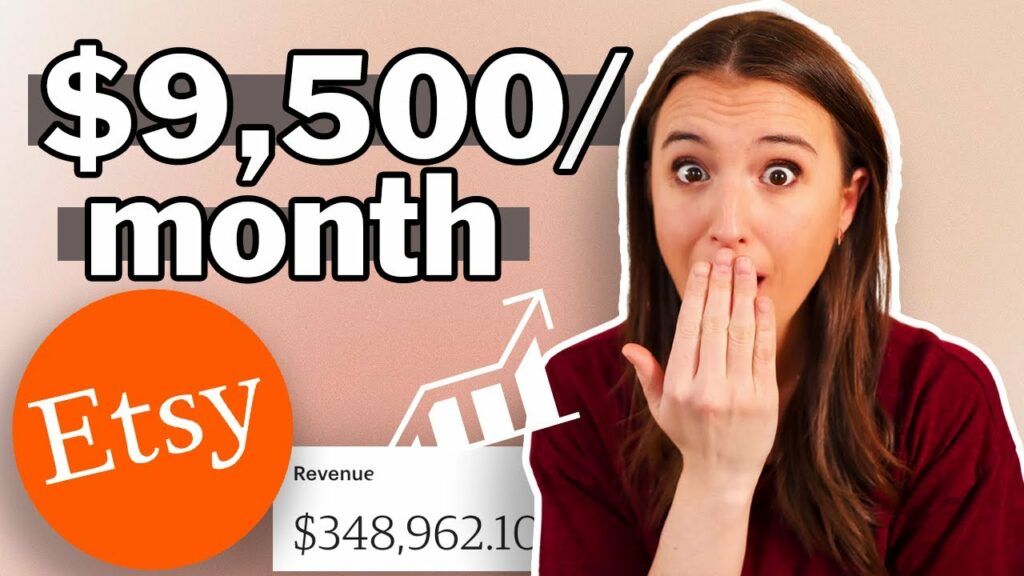Sharing is caring! ʕっ• ᴥ • ʔっ ♥

Ever dreamed of selling your creativity to 90 million buyers and getting paid for it? Whether it’s handmade jewelry, printable planners, or vintage treasures, Etsy is one of the easiest ways to turn passion into profit online.
With over 90 million active buyers hunting for one-of-a-kind gifts, home décor, and custom creations, your side hustle could grow into a full-time income.
Here’s the catch Etsy is competitive, and simply opening a shop won’t guarantee sales. To stand out, you’ve got to master what actually sells, how to set up your shop the right way, and the exact strategies sellers use to pull in thousands every month.
That’s exactly what this guide breaks down so you can skip the guesswork and start selling faster. We’ll cover everything from top-selling products on Etsy to the exact FAQs beginners ask. You’ll walk away knowing how to start, grow, and profit from your shop without the trial and error.
Ready to turn your Etsy passion into real profit? Let’s dive in! 🚀
Key Takeaways:
Print-on-demand keeps things simple. No inventory, no shipping just tools like Printify that let you design, sell, and profit headache-free.
Picking the right niche matters. When I focused on products my audience craved, my shop finally gained real traction.
Etsy SEO is the game-changer right keywords in titles and descriptions shot my listings to the top and brought in buyers.
Pinterest, email, Etsy Ads marketing turned browsers into buyers.
Etsy Stats show me what works, so I tweak, stay competitive, and stop guessing because guessing doesn’t pay the bills.
SAVE THIS PIN FOR LATER

Pick a Profitable Product Category
If you want to make money on Etsy, your first move is picking the right niche. Your niche is exactly who you’re selling to the specific group whose needs you’ll meet and whose wallets you’ll earn. Nail this, and your products, branding, and marketing practically fall into place.
Here’s how I frame it:
Broad niche: pet owners.
Super-specific niche: dog moms who love matching outfits with their pups. (Yep, that’s a real money-maker on Etsy!)
The tighter your niche, the easier it is to stand out. When I focused on a clear group of buyers, my sales jumped within weeks.
So before you open your shop, get crystal clear: Who exactly are you serving? This answer will guide every decision you make and every profit you earn.
Dig Deep Into Your Interests
Here’s the truth: if your shop feels like a Monday morning, you won’t stick with it—and neither will your customers.
When I picked a niche I loved, writing descriptions, designing products, and promoting my shop became effortless. Passion doesn’t just keep you motivated; it shows through in your work and attracts buyers who vibe with your energy.
Think about your own skills, goals, and experiences:
Artistic? Turn your artwork into prints or digital downloads.
Love home décor? Sell cozy, unique pieces that buyers crave.
Obsessed with pets? Cater to loyal, profitable pet parents.
Bottom line? Your shop will thrive and profits will follow when it reflects something you truly care about.
Pinpoint Customer Needs
Here’s the truth: it doesn’t matter how much you love your product if customers don’t want it, your Etsy shop won’t make money. That’s why the first step is figuring out exactly what buyers are already searching for.
And the good news? You don’t have to guess. Shoppers are constantly telling us what they want through their searches and shopping behavior.
Here’s how to dig into customer needs:
Etsy search bar Start typing a keyword and watch what auto-fills. Those suggestions are real buyer searches in real time.
Google Trends & Semrush.Perfect for spotting whether a product idea is trending up or losing steam.
Social platforms (like Pinterest or Quora) People openly share what they love—and complain about what they can’t find. That’s your opportunity.
When you create products that line up with what people are already searching for, you don’t have to push so hard to make sales. Instead, customers come to you—and that’s the fastest way to make money on Etsy without wasting time on products no one wants.
Research the Market and Competition
Etsy is full of sellers but that’s actually a good thing. Why? Because competition means buyers are already spending money in your niche. The real trick is figuring out how to stand out.
Here’s how to research competitors the smart way:
Check their bestsellers If the same product types keep popping up across multiple shops, that’s proof buyers are hungry for them.
Study pricing: Are shops going for budget-friendly volume sales or charging premium prices for higher quality? This helps you decide how to position yourself.
Read reviews: Customers literally tell you what they love and what frustrates them. If reviews complain about slow shipping or poor quality, that’s your chance to do better.
The goal isn’t to copy it’s to spot what works and then ask: How can I make my version better or more unique? Maybe that’s sharper branding, upgraded photos, or offering customization.
By analyzing the competition before jumping in, you save time, avoid wasted money, and give your shop the best chance to stand out instead of getting lost in the crowd.
Prepare Your Etsy Shop and Products
This is where things start to get exciting! After locking in my niche and strategy, the next step was setting up my Etsy shop and stocking it with products people actually want to buy.
Here’s what I focus on every time:
A customer-focused catalog: Every product has to connect to my niche and solve a need for my buyers. No random filler only items that make sense for my audience.
Smart pricing: I research competitors and factor in costs to make sure my prices stay profitable while still looking attractive to shoppers.
Click-worthy listings: Shoppers scroll fast, so titles, photos, and descriptions have to grab attention instantly. Think lifestyle photos, clear keywords, and benefit driven copy that makes buyers hit “Add to Cart.”
Your Etsy shop is your storefront and first impressions matter. A polished shop with irresistible listings can be the difference between silence and steady sales.
And the best part? Once your listings are live, they work for you 24/7 helping you make money on Etsy even while you’re busy with mom life.
Step 1: Pick Products and Designs
Now for the fun part: choosing what you’ll actually sell! The goal isn’t just to pick popular items but to give them a unique twist that sets your shop apart.
I like to start by checking what’s trending on Etsy things like tote bags, mugs, candles, or digital printables. Then I ask: How can I make this stand out? A clever design or personalized touch can transform an everyday product into a bestseller.
This is where Printify has been a total game-changer. Their catalog includes 1,300+ white-label products everything from pint glasses and t-shirts to puzzles and kitchen gear. With their beginner-friendly Product Creator, I can design products quickly without pro-level design skills.
If you’re offering personalized items (which buyers love!), Printify’s Automated Personalization for Etsy makes it seamless. Customers type in their name or message, it instantly appears on the design, and all I have to do is approve. No back-and-forth emails, no headaches—just smooth, simple sales.
Bottom line? Picking the right products and giving them your own creative twist is one of the fastest ways to build momentum on Etsy and enjoy the process along the way.
Step 2: Get Your Pricing Right (a.k.a. Know Your Numbers)
This is where most Etsy beginners mess up they slap a price on their products without really calculating costs. And trust me, nothing kills motivation faster than realizing you’re barely breaking even.
If you want to actually make money on Etsy, you’ve got to know your numbers. That means adding up every single expense before setting your prices. Here’s what to include:
Production costs Materials, packaging, shipping, and even taxes.
Listing fees Etsy charges $0.20 per listing, no matter what.
Transaction fees Etsy takes 6.5% of the total sale price (yep, including shipping).
Payment processing fees – For U.S. sellers, that’s 3% + $0.25 per order.
When you put it all together, Etsy usually takes 10–20% per sale. If you’re using print-on-demand (like I do with Printify), your provider already bundles in production and shipping, so profit calculations are way easier.
Quick Tip: Use an Etsy fee calculator. Plug in your product price, cost, and shipping, and it’ll instantly show you your profit per sale. It’s the fastest way to avoid underpricing.
Bottom line? Etsy is totally worth it—but only if you price strategically. Once I nailed my numbers, my shop went from making pennies to making real profit.
Step 3: Open Your Etsy Shop
Now for the fun part you’re finally opening your Etsy shop! The setup is super beginner-friendly, and honestly, once I went through it myself, I realized it’s way less intimidating than it looks.
Here’s the step-by-step:
Create your Etsy account Use a business email (trust me, it keeps things organized) and follow the prompts.
Set up your store details Choose your shop name, language, and currency. Pro tip: pick a name that fits your niche but is still easy to remember.
Add your first product listing I use Printify to design products and create mockups. Then I upload the photos, write a benefit-packed description, and set my price + shipping.
Connect your bank account Etsy pays you directly through Etsy Payments, so don’t skip this step if you actually want to get paid (arguably the best part!).
Pro Tip: If you’re using Printify, take advantage of the free Etsy integration. It syncs your custom products with Etsy, so posting your first listing is literally just a few clicks.
Once your shop goes live congrats, you’re officially an Etsy seller! 🎉 From here, it’s all about optimizing your listings and marketing to start making consistent sales.
Step 4: How to Enhance Your Etsy Store
Okay you’ve opened your Etsy shop, but how do you make it stand out from thousands of other sellers? Think of your store as a little boutique: the more inviting and well-organized it looks, the more likely people are to buy from you. Here’s how to take your shop from basic to irresistible:
- Add Essential Store Details
Your shop is your brand. Write an engaging shop description that tells buyers what makes your products unique. Upload an eye-catching banner (this is like your storefront window) and fill in the About section with your story, values, and business info. Buyers love connecting with real people, not faceless brands.
- Organize and Create Compelling Listings
This is where most sellers drop the ball—but not you. Don’t just dump products into your shop; organize them into clear categories so customers can browse easily. Upload multiple listings (the more you have, the more chances you have to get found in Etsy search).
Then, make each listing shine:
Use bright, high-quality photos from multiple angles.
Write benefit-driven descriptions that answer buyer questions.
Sprinkle in keywords and tags so your products show up in search.
Pro Tip: Think like a buyer. If you were searching Etsy, what exact words would you type in? Use those phrases in your titles and tags to boost visibility.
Step 5: Create a Marketing Strategy
So, your Etsy shop is live—congrats! But here’s the truth: just because you built it doesn’t mean shoppers will magically find it. You need a marketing strategy to drive traffic, boost sales, and keep customers coming back.
Here’s your game plan:
Optimize for Etsy SEO
Treat Etsy like Google: if you don’t show up in search, you won’t get sales. Use keywords in your titles, tags, and descriptions. Bonus: long-tail keywords (like “boho wall art digital download”) usually convert better than broad ones.
Leverage Social Media
Pinterest, Instagram, and TikTok are goldmines for handmade and unique products. Don’t just post plain product shots share lifestyle content that shows your items in use.
Build an Email List
Etsy limits your direct connection with customers, so grow your own list. Offer a discount code or freebie in exchange for sign-ups, then use it to promote new products, sales, and special offers.
Run Paid Ads (Strategically)
Start small with Etsy Ads to test which products perform best. Once you know your winners, expand to Pinterest or Instagram ads for broader reach.
Focus on Customer Retention
Happy buyers repeat buyers. Send thank-you notes, include a coupon for their next purchase, and deliver amazing service. Positive reviews will naturally boost your shop’s credibility and sales.
Quick Win: A shop with just 10–15 well-optimized listings + consistent social media promotion can outperform a shop with 100+ listings and no marketing strategy.
Step 6: Define Your Target Customer
Here’s the truth: if you try to sell to everyone, you’ll end up selling to no one. The most successful Etsy shops know exactly who their ideal customer is and they tailor their products, listings, and marketing to that person.
That’s where your buyer persona comes in. Think of it as a snapshot of your perfect customer: who they are, what they value, and why they’d choose your shop.
Ask yourself:
Who’s most likely to buy my products? (Moms? Students? Pet owners? Newlyweds?)
Why would they choose me over others? (Unique design, eco-friendly materials, affordable gifts, personalized items?)
Where do they hang out online? (Pinterest, Instagram, TikTok, or Etsy searches?)
How much are they willing to spend? (Budget shoppers or premium buyers?)
Build your buyer persona by jotting down details like:
Age & Gender Are your products trendy for Gen Z or timeless for moms in their 40s?
Location Are they U.S.-based, or are you targeting international buyers too?
Income Level Can they afford premium handmade items, or are they hunting for budget finds?
Interests & Hobbies Do they love home décor, fashion, pets, or DIY crafts?
Example: If you sell boho wall art, your persona could be:
“Emma, a 28-year-old interior design lover in the U.S., earns $50k/year, scrolls Pinterest daily, adores cozy home décor, and happily spends $30–50 on unique digital prints.”
Once you have this clarity, everything clicks into place—your photos, keywords, and pricing strategy all speak directly to your Emma.
Step 7: Choose Your Best Marketing Channels
Yes, Etsy’s search engine drives traffic but if you want to stand out and scale, you’ll need to market outside of Etsy too. The more often people see your shop, the more likely they are to click, trust, and buy.
Here are some of the best channels for Etsy sellers:
Email Marketing, Start building your list early. Use it to send new product drops, special discounts, gift guides, and even behind-the-scenes updates. Email keeps your brand top-of-mind and brings past buyers back.
Pinterest Perfect for Etsy products since it’s a visual search engine. Create pins that link directly to your listings and boards that match your niche.
Instagram & TikTok Share styled product photos, reels, and short videos. Showcase how your products look in real life and use trending sounds to boost reach.
Collaborations & Influencers Partner with micro-influencers or fellow Etsy sellers to tap into new audiences.
The key is not to spread yourself too thin. Pick 1–2 platforms where your ideal customer (your “Emma”) already spends time, and focus your energy there.
How to Market Your Etsy Shop (Without Feeling Overwhelmed)
Etsy SEO (Search Engine Optimization)
Think of Etsy as Google for handmade products—keywords are how shoppers find you.
Use tools like eRank or Ahrefs to spot high-ranking phrases.
Add them naturally to your titles, tags, and descriptions.
Focus on long-tail keywords (e.g., “boho macrame wall hanging” instead of just “wall décor”).
Social Media Marketing
Instagram, TikTok, and Pinterest are goldmines for Etsy sellers.
Post lifestyle shots and behind-the-scenes clips.
Jump on trending sounds and hashtags.
Use Stories and Reels to connect with your audience.
Social media is where your products get discovered—and where real customer loyalty starts.
Online Ads
Have a budget? Ads give your shop instant visibility.
Use Etsy Ads to show up in search results.
Run Facebook/Instagram Ads to spotlight your best-sellers.
Test Google Shopping Ads for high-intent buyers.
Content Marketing
Don’t just sell educate and inspire. Content makes you memorable.
Write blog posts like “How to Style a Boho Living Room.”
Post YouTube tutorials such as “DIY Home Décor Ideas.”
Create Pinterest pins that link straight back to your shop.
This builds trust and positions you as the go-to brand in your niche.
Influencer Marketing
Borrow attention from people who already have your dream customers.
Send free products in exchange for honest reviews.
Run sponsored posts or giveaways.
Partner with micro-influencers their smaller audiences often engage more.
Pro Tip: Don’t spread yourself too thin. Start with two marketing channels (like Etsy SEO + TikTok), nail them, and expand once you’re seeing consistent sales.
Promote With Paid Etsy Ads
Etsy Ads are one of the quickest ways to boost your shop’s visibility and drive sales directly from search results. They run on a cost-per-click (CPC) model—meaning you only pay when someone clicks your ad.
How Etsy Ads Work
Open Shop Manager
Log in to your Etsy account and head to your Shop Manager dashboard.
Go to Marketing Tools
In the left-hand menu, click Marketing, then select Etsy Ads.
Set Your Daily Budget
Decide how much you want to spend per day. Etsy will automatically maximize exposure within your budget.
Choose Your Listings
Select the products you want to advertise. Etsy usually recommends your top performers, but you can pick manually too.
Launch Your Ads
Once you’re happy with your setup, hit Activate. Your ads will begin appearing in relevant search results.
Pro Tip: Start small—around $5–10/day—to test what works. Track performance, double down on best-sellers, and scale your budget as sales grow.
Track, Analyze, Optimize, Repeat
Selling on Etsy isn’t a “set it and forget it” game. To keep growing, you need to regularly check what’s working, fix what’s not, and double down on your winners. Think of it like a loop:
Track → Analyze → Optimize → Repeat.
Here’s how it works:
- Track Your Performance
Start by monitoring your shop’s numbers. Head into your Etsy Shop Stats to see visits, clicks, favorites, and sales. These numbers tell you how shoppers are finding your products and which listings grab attention.
If you want to dig deeper, use tools like eRank or Marmalead to see keyword performance and how your products compare to competitors.
- Analyze the Insights
Don’t just glance at numbers—look for patterns.
Which listings are bringing in the most traffic?
Are customers actually buying, or just clicking and leaving?
Which keywords are ranking higher in search?
This is where you spot your winners (best-sellers) and underperformers.
- Optimize Your Store
Now use those insights to take action:
Tweak keywords on listings with low visibility.
Improve photos or descriptions on items that get clicks but not sales.
Create variations (like colors, bundles, or sizes) for best-sellers to maximize revenue.
Pause ads for products that don’t convert and shift budget to proven winners.
Each tweak brings you closer to a more profitable shop.
- Repeat the Loop
Etsy success isn’t about guessing—it’s about testing, improving, and repeating. The more you refine, the more you learn about your buyers. Over time, your shop becomes sharper, more optimized, and more profitable.
Pro tip: Schedule a weekly “Etsy Check-In.” Spend 30–60 minutes reviewing stats, making adjustments, and testing one small change. Those tiny tweaks compound into big wins.
10 Best-Selling Categories on Etsy (and Why They Work)
Thinking about starting an Etsy shop? The secret to success isn’t just making beautiful products—it’s knowing what shoppers are already buying. Etsy buyers crave personalization, handmade touches, and items they can’t grab at big-box stores.
Here are the top categories dominating Etsy (and how you can stand out).
- Jewelry – Personalization Is Key
Best-sellers: Necklaces, earrings, bracelets, engagement rings
Why it works: Shoppers want meaningful, one-of-a-kind pieces (think initials, birthstones, or custom names)
Pro tip: Highlight personalization in your photos and titles—shoppers love when jewelry tells a story.
- Crafts & Supplies – Fueling DIY Creators
Best-sellers: Beads, fabrics, tools, digital downloads (SVGs, patterns)
Why it works: Makers and hobbyists flock to Etsy for niche supplies they can’t find elsewhere
Pro tip: Digital files = passive income. One upload can sell endlessly without inventory headaches.
- Home Décor – Unique Touches for Every Style
Best-sellers: Wall art, candles, throw pillows, macrame plant hangers
Why it works: Shoppers want décor that feels personal—not something mass-produced from Target
Pro tip: Jump on seasonal trends (fall wreaths, holiday ornaments) to capture repeat buyers.
- Clothing – Wear Your Personality
Best-sellers: Handmade dresses, graphic tees, sweatshirts, baby outfits
Why it works: People love expressing themselves through fashion that isn’t cookie-cutter
Pro tip: Use print-on-demand to test designs risk-free before committing to bulk orders.
- Wedding Items – Forever in Demand
Best-sellers: Invitations, veils, bridal party gifts, cake toppers
Why it works: Couples want custom, memorable touches for their big day
Pro tip: Focus on trending wedding themes (rustic, boho, minimalist) to match what brides are searching for.
- Toys & Games – Nostalgia Meets Creativity
Best-sellers: Wooden toys, puzzles, educational games, plushies
Why it works: Parents want safe, creative alternatives to mass-market toys
Pro tip: Eco-friendly materials (like wood or organic fabrics) appeal to modern parents.
- Digital Products – Low Cost, High Reward
Best-sellers: Printables, planners, wall art, templates
Why it works: Zero shipping costs + unlimited sales = pure profit
Pro tip: Canva templates, wedding planners, and wall art are trending digital products.
- Vintage Finds – Etsy’s Treasure Trove
Best-sellers: Retro clothing, antique jewelry, old books, collectibles
Why it works: Etsy is one of the few places shoppers expect to find vintage gems
Pro tip: Great photography + detailed item history helps build trust with buyers.
- Pet Products – For the Fur Babies
Best-sellers: Custom collars, pet beds, clothing, portraits
Why it works: Pet parents are big spenders (and love spoiling their pets)
Pro tip: Personalized pet tags and portraits are constant best-sellers.
- Beauty & Self-Care – Handmade Is Hot
Best-sellers: Soaps, candles, skincare, bath bombs
Why it works: Buyers love natural, artisanal alternatives to store-bought products
Pro tip: Lean into wellness trends (like lavender, rose, or eco-friendly packaging).
Final Takeaway
The best-selling Etsy categories all have one thing in common: personalization and uniqueness. Whether it’s a custom necklace, a printable planner, or a handmade wedding gift, shoppers are searching for items that feel special and authentic.
How to Make Money on Etsy: FAQ
Thinking about starting an Etsy shop but have a million questions? Don’t worry—I’ve got you covered. Here are the most common Etsy FAQs, answered simply and clearly, so you can start selling with confidence.
- Can you really make money on Etsy?
Yes! Thousands of sellers earn part-time and even full-time incomes. Your success depends on:
Picking profitable products
Optimizing your listings for search (SEO)
Actively marketing your shop
- What sells best on Etsy?
Top categories that consistently do well include:
Jewelry – Personalized and handmade pieces
Crafts & supplies – For DIY lovers and creators
Wedding items – Decor, gifts, and accessories
Clothing & accessories – Especially unique, custom pieces
Home decor – Wall art, candles, organizers
Baby items – Personalized gifts for new parents
Pet supplies – Collars, tags, custom beds
Digital downloads 📥 – Art, planners, templates
Pro tip: Unique, personalized, and handmade products sell best because shoppers can’t find them on Amazon.
- Do I have to sell handmade items?
Nope! Besides handmade goods, you can also sell:
Vintage items (20+ years old)
Craft supplies
Digital products (printables, planners, SVG files, artwork)
- How much does it cost to start?
Etsy is super affordable. Fees include:
$0.20 listing fee per item
6.5% transaction fee per sale
3% + $0.25 processing fee (varies by country)
Bonus: If you sell digital products or use print-on-demand, you don’t need upfront inventory.
- Can I earn passive income on Etsy?
Yes! Digital downloads are the ultimate passive product. You create it once, and it sells unlimited times without extra work.
- How do I get my first sales?
Use SEO keywords in your titles, tags, and descriptions
Upload high-quality, eye-catching product photos
Set competitive prices
Promote your shop on Pinterest, Instagram, or TikTok
Ask friends/family to help spread the word
- Is Etsy too saturated?
Some niches (like jewelry) are competitive but you can still succeed by:
Targeting micro-niches
Offering personalization
Creating items people can’t find on Amazon
- Do I need a business license?
Etsy doesn’t require one to open a shop.
But your local laws might always check your country’s business and tax regulations.
- How much can beginners really make?
Hobby sellers: A few hundred dollars/month
Side hustlers: $1,000–$5,000/month
Full-time shops: $10,000+/month
It all depends on your product demand, marketing, and consistency.
- Biggest mistakes new sellers make
Poor product photos
Ignoring SEO in titles & tags
Pricing too low (or too high)
Giving up too soon (Etsy takes time to grow!)
Not promoting outside of Etsy
Final Thoughts
Etsy is full of opportunities, but success doesn’t come from luck it comes from strategy. The sellers who win are the ones who choose profitable niches, create products buyers actually want, and keep improving their shops with SEO, marketing, and customer care.
If you treat your Etsy store like a real business instead of a side hobby, the results will follow.
When I sold my very first mug on Etsy, it was only a $20 order but I still danced around my kitchen like I had just won the lottery.
That one tiny sale proved something big: this works. And once you get that first notification, your motivation skyrockets. Every little win builds momentum until your shop becomes a real income stream.
So here’s my challenge for you: don’t just dream about making money on Etsy, start today. Open your shop, list your first product, and take the leap. The sooner you begin, the sooner you’ll experience that first sale and trust me, it’s the best feeling ever.






